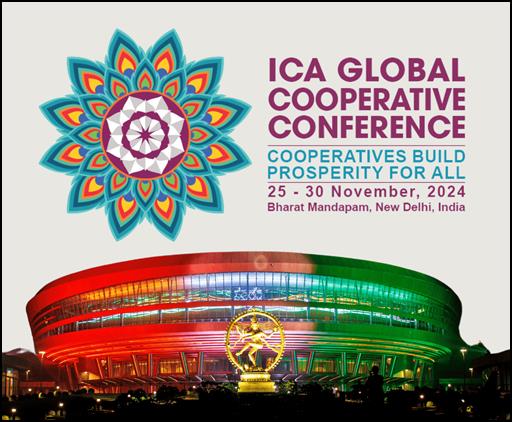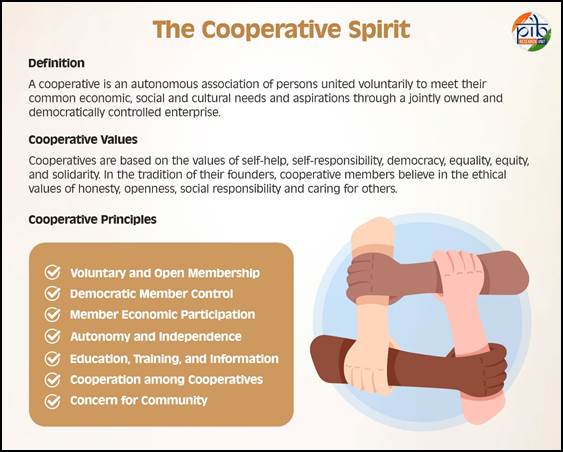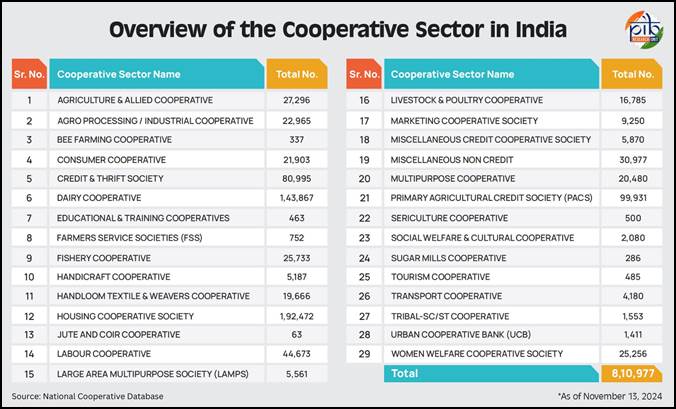Others
India’s Cooperative Movement: Driving Inclusive Growth
Over 8 Lakh Societies Empowering 29 Sectors Across India
Posted On:
14 NOV 2024 5:20PM
Introduction
The cooperative movement in India has deep roots, drawing inspiration from the ancient Indian ethos of Vasudhaiva Kutumbakam, which translates to "the world is one family." This enduring principle of unity and mutual support has fostered the growth of cooperatives as vital institutions that empower local communities and drive grassroots development. According to the International Cooperative Alliance (ICA), cooperatives are member-owned enterprises that prioritize shared economic, social, and cultural objectives, placing people above profit. In India, cooperatives have transformed countless lives by enabling marginalized communities to access resources, secure livelihoods, and participate in the economy.

The establishment of the Ministry of Cooperation on July 6, 2021, underscored India's commitment to enhancing the cooperative sector. The Ministry envisions an inclusive, cooperative-driven economic model that reaches every village, strengthening socio-economic bonds across regions. As India prepares to host the ICA’s Global Conference in November 2024, an event facilitated by the Indian Farmers Fertilizer Cooperative (IFFCO) and supported by India’s 18 ICA member organizations, the country stands poised to further elevate the cooperative movement both nationally and globally.
Understanding Cooperative Societies
A cooperative society is a voluntary organization where individuals with shared needs come together to achieve common economic goals. These societies are founded on principles of self-help and mutual assistance, aiming primarily to serve the interests of disadvantaged sections of society rather than to generate profits. Members pool their resources and utilize them collectively to derive shared benefits, making the cooperative structure distinct in its emphasis on community welfare.

Some different types of Cooperative Societies in India:
Consumers’ Cooperative Society: Formed to provide consumer goods at reasonable prices, eliminating middlemen by purchasing directly from producers. Examples include Kendriya Bhandar and Apna Bazar.
v Producers’ Cooperative Society: Supports small producers by providing necessary production items such as raw materials and equipment. Notable examples are APPCO and Haryana Handloom.
Cooperative Marketing Society: Assists small producers in marketing their products by collectively selling on their behalf. The Gujarat Cooperative Milk Marketing Federation (AMUL) is a prominent example.
Cooperative Credit Society: Provides financial assistance to members by accepting deposits and granting loans at reasonable interest rates. Examples include Village Service Cooperative Society and Urban Cooperative Banks.
Cooperative Farming Society: Small farmers form these societies to gain benefits of large-scale farming. Examples include lift-irrigation cooperatives and pani-panchayats.
Housing Cooperative Society: Offers affordable residential options by purchasing and developing land for members. Examples include Employees’ Housing Societies and Metropolitan Housing Cooperative Society.
Evolution of Cooperative Movement in India
Even before the formal establishment of cooperative structures through legislation, the principles of cooperation were already ingrained in various parts of India. Village communities often engaged in collective activities, creating permanent assets such as village tanks or forests known as Devarai or Vanarai. These community efforts were vital to local survival and prosperity. In different regions, various forms of cooperation emerged, such as Chit Funds, Kuries, Bhishies, and Phads. In the Madras Presidency, Mutual-Loan Associations, also called ‘Nidhis’, were organized to provide financial support. In Punjab, a cooperative society was established in 1891 to manage common village land for the benefit of all co-sharers. These efforts, however, were voluntary and informal, operating outside the official framework.
The modern cooperative movement in India began to take shape in response to the distress and turmoil of the late 19th century. The aftermath of the Industrial Revolution led to widespread displacement of rural populations, with many turning to agriculture as the sole means of livelihood. However, agricultural practices were hampered by issues such as land fragmentation, which rendered farming uneconomic, and the rigid collection of land revenues. Farmers faced recurring challenges such as erratic rainfall, poor crop yields, and a growing dependence on moneylenders, who often offered high-interest loans or bought crops at exploitative prices. These harsh conditions underscored the urgent need for affordable credit, paving the way for the formalization of the cooperative movement as an alternative means of financial support for farmers and rural communities.
The history of Cooperative Movement in India can be divided into two phases. First, cooperative Movement in the Pre-Independence era and second in the Post-Independence era.
Cooperative movement in the Pre Independence-Era
Cooperatives became a legal entity in India in 1904 with the introduction of the "Cooperative Credit Societies Act," which outlined the norms for constituting cooperative societies, membership, registration, liabilities of members, disposal of profits, rulemaking power, and dissolution. However, it was restrictive, excluding non-credit and other societies from its scope.
The Cooperative Societies Act of 1912 addressed the shortcomings of the 1904 Act, expanding the scope to include marketing societies, handloom weavers, and other artisan societies. In 1914, the Maclagan Committee recommended reforms for credit societies, proposing a three-tier cooperative banking system at the Centre, Province, and District levels.
The Government of India Act of 1919 empowered provinces to enact laws for cooperatives, leading to the passage of the Bombay Cooperative Society Act of 1925, the first cooperative legislation by a provincial government.
In 1942, the Government of India enacted the Multi-Unit Cooperative Societies Act to regulate cooperatives with membership from multiple provinces and delegated the power of the Central Registrar of Cooperatives to State Registrars for practical purposes.
Cooperative movement in the Post Independence-Era
After Independence, the new government system aimed to decentralize economic power and promote people’s participation in planning and implementing economic development programs, with a focus on social justice. Cooperatives became an integral part of India’s Five-Year Plans, starting with the First Plan, which emphasized their coordination with village panchayats.
The establishment of the National Cooperative Development Corporation (NCDC) in 1963 and the National Bank for Agriculture and Rural Development (NABARD) in 1982 were key milestones in supporting rural credit and cooperative development.
In 1984, the Indian Parliament passed the Multi-State Cooperative Organisations Act to streamline laws governing cooperatives across states. Further consolidation occurred with the introduction of the National Policy on Cooperatives in 2002, aiming to harmonize the legal framework.
The MSCS Amendment Act 2023 and associated rules seek to enhance governance, increase transparency, and implement structural changes within Multi-State Cooperative Societies (MSCS), empowering cooperatives with greater independence.
Resurgence of the Cooperative Movement in India
The Ministry of Cooperation (MoC), established on 6th July 2021, has played a pivotal role in revitalizing the cooperative movement in India. It has spearheaded various schemes and initiatives to create a robust administrative, legal, and policy framework for the sector's advancement. A key focus of the MoC is the promotion of Multi-State Cooperative Societies and streamlining procedures to enhance the "Ease of Doing Business" for cooperatives. The Ministry's efforts are centred on modernizing and strengthening cooperatives, fostering transparency through computerization, and promoting competitiveness. Additionally, there is a strong emphasis on ensuring inclusive development, particularly for underserved rural communities. Through its initiatives, the MoC aims to connect every village to cooperatives, driving economic prosperity under the banner of 'Sahakar se Samriddhi,' contributing to the nation's overall growth.
Key Government Initiatives for Upgrading the Cooperative Sector (As of February 6, 2024):
Model Bye-Laws for PACS: New Model Bye-Laws enable PACS to undertake 25+ activities, improve governance, and ensure inclusivity, with 32 States/UTs adopting them.
Computerization of PACS: A ₹2,516 Crore project aims to computerize 63,000 PACS, improving efficiency and linking them with NABARD. 62,318 PACS from 28 States/UTs are included, with 15,783 PACS already onboarded.
New Multipurpose PACS/Dairy/Fishery Cooperatives: Over 9,000 new PACS/dairy/fishery cooperatives are being established in uncovered Panchayats with support from various federations.
Decentralized Grain Storage Plan: A plan to create warehouses and agri-infrastructure at PACS level, reducing food grain waste and transportation costs, with 2,000 PACS identified for the pilot project.
PACS as Common Service Centers (CSCs): An MoU with MeitY and NABARD enables 30,647 PACS to offer 300+ e-services to rural citizens.
Formation of Farmer Producer Organizations (FPOs): 1,100 additional FPOs will be formed by PACS to improve market linkages for farmers.
Retail Petrol/Diesel Outlets: 240 PACS have applied for retail petrol/diesel outlets, with 39 selected so far.
LPG Distributorship for PACS: PACS can now apply for LPG distributorships, with 9 applications received from 3 States/UTs.
PM Bhartiya Jan Aushadhi Kendra: 2,475 PACS have been approved to operate as Janaushadhi Kendras, improving access to generic medicines.
Pradhan Mantri Kisan Samriddhi Kendras (PMKSK): 35,293 PACS are now functioning as PMKSK to provide fertilizers and related services to farmers.
PM-KUSUM Convergence: Farmers associated with PACS can adopt solar water pumps for irrigation.
Operations & Maintenance of Rural Water Supply: 1,630 PACS are selected to carry out O&M of rural piped water supply schemes in 14 States/UTs.
Micro-ATMs for Cooperative Societies: 1,723 Micro-ATMs have been distributed to Bank Mitra cooperatives for doorstep financial services in Gujarat.
RuPay Kisan Credit Cards for Dairy Cooperatives: 1,23,685 RuPay KCCs have been distributed to dairy cooperative members in Gujarat.
Formation of Fish Farmer Producer Organizations (FFPOs): NCDC has registered 69 FFPOs and is converting 1,000 fisheries cooperatives into FFPOs with an outlay of ₹225.50 Crore.
Cooperative Sector at a Glance
Cooperative societies in India operate across various sectors such as Agriculture, Credit and Banking, Housing, and Women’s Welfare. They are instrumental in promoting financial inclusion by providing credit to farmers and small entrepreneurs who may have difficulty accessing conventional banking services. These societies play a crucial role in rural development, empowering local communities and reducing socio-economic disparities.

Conclusion
India's cooperative movement, deeply rooted in its cultural and socio-economic landscape, has evolved into a powerful vehicle for inclusive growth, community empowerment, and rural development. Through the establishment of the Ministry of Cooperation and its recent initiatives, the government has reaffirmed its commitment to fostering a cooperative-driven model that reaches every corner of the country, facilitating sustainable livelihoods and financial inclusion for marginalized communities. The upcoming Global Conference of the International Cooperative Alliance (ICA), hosted by India in November 2024, marks a significant milestone in this journey, offering a platform to showcase India's innovative strides in the cooperative sector to a global audience. This event not only highlights India's dedication to strengthening cooperatives nationally but also its leadership role in advancing the cooperative model worldwide, reinforcing the vision of 'Sahakar se Samriddhi' as a guiding principle for prosperity and unity.
References:
Click here to see in PDF:
Santosh Kumar/ Sheetal Angral/ Saurabh Kalia
(Backgrounder ID: 153419)
Visitor Counter : 9249
Provide suggestions / comments